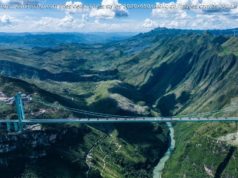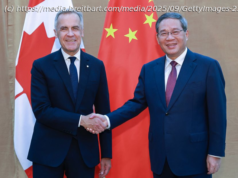Beijing has a grand plan to reshape global trade, putting China at the heart of a massive international trade network.
Beijing has a grand plan to reshape global trade, putting China at the heart of a massive international trade network.
China’s One Belt, One Road (OBOR) initiative is an enormous and ambitious trade, integration, and infrastructure development project that aims to create a land-based Silk Road Economic Belt (SREB) and a sea-based Maritime Silk Road (MSR) . The Belt and Road project, based on aspects of Chinese history, was officially announced by Chinese President Xi Jinping almost four years ago and is considered a part of the government’s efforts to facilitate the “great revival of the Chinese nation.”
While China once tried to “hide its light” and “bide its time, ” China is now pouring significant state resources into an initiative that could transform China into a leader in globalization. Chinese investment in the countries and projects along the OBOR could reach $130 billion annually over the next five years, according to some projections.
China is pumping tons of money into roads, pipelines, railroads, ports, and other key infrastructure projects. More than $900 billion in projects are planned or underway in countries located along the Silk Road trade routes, Fitch Ratings explained in a recent report.
Around 1,500 delegates from 130 countries, including heads of state and the directors of several international financial institutions, are expected to attend a two-day summit on the “Belt and Road” project in Beijing Sunday. China’s Xinhua News Agency claims that the OBOR is “a Chinese solution to global economic blues.”
The U. S. will send a delegation to take part in the summit.
While China presents the OBOR as an altruistic endeavor, many observers remain skeptical and suspicious.
The project covers roughly 65 percent of the world’s population, 75 percent of its energy resources, and 40 percent of its GDP, leading many experts to conclude that the OBOR is designed to boost China’s global influence, especially since all roads run through China. Some observers have described the Belt and Road as the largest development push in history.
Beijing denies that its initiative is an attempt to increase Chinese power or dominate global trade, accusing critics of unfairly politicizing a positive endeavor.
A key cause for concern is that the project is without parameters, as Beijing claims that any country, company, organization anywhere on the planet can be a part of the Belt and Road. Furthermore, it is unlikely that the project will see returns on investments for many years. In some cases, investments in risky states may fail to yield results.
“Will this month’s event be remembered as a step in the next stage of globalizing China’s economy, or as a huge white elephant that left an enormous amount of wasted resources strewn along its path, ” Jorge Wuttke, president of the EU Chamber of Commerce in China, wrote in a recent op-ed in the Financial Times.
He described China’s initiative as “less of a practical plan for investment than a broad political vision.”
To a certain extent, the Belt and Road project opens up and creates new markets for Chinese goods and services at a time when China’s economic growth is slowing. It may also be an opportunity for China to export its overcapacity, as well as encourage development in its distinctly underdeveloped western regions.
While some countries are genuine supporters, others fear that they may become indebted to Beijing, essentially allowing China to turn its neighbors into economic vassal states. China has yet to clearly outline how the OBOR will be financed.
Additionally, it is unclear how security issues will be addressed. “We don’ t really know much about co-financing in the host governments, and the kinds of debts and repayments that are going to be involved, ” Carlyle Thayer, emeritus professor at the Australian Defence Force Academy, explained to TIME reporters. “And all that infrastructure spanning out from Western China can be hostage to instability.”
“The upcoming summit would be the right time for China to come clean about its ultimate goals, ” Ankit Panda, a senior editor for The Diplomat, asserts in his assessment of China’s global trade initiative.
Follow Ryan on Twitter
Send tips to ryan@ dailycallernewsfoundation.org .
Content created by The Daily Caller News Foundation is available without charge to any eligible news publisher that can provide a large audience. For licensing opportunities of our original content, please contact [email protected] .






